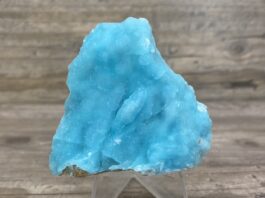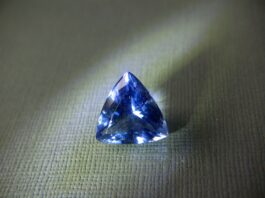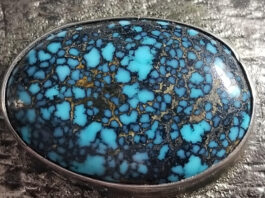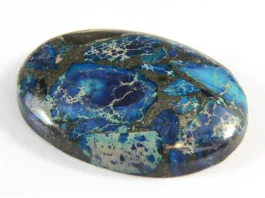Jasper is a type of mineral that is primarily composed of silica, with other trace elements and impurities giving it its unique colors and patterns. It is a member of the chalcedony family and is typically opaque, although some varieties can be translucent. Jasper is a common mineral that is found in many locations around the world, including the United States, Australia, Brazil, Egypt, and India.
Jasper has been used by humans for thousands of years and has been found in archaeological sites dating back to the Neolithic period. It has been used for a variety of purposes, including as a tool for cutting and engraving, as a material for jewelry and decorative objects, and for ceremonial purposes. In some cultures, Jasper has been considered to have healing properties and has been used in traditional medicine.

There are many different types of Jasper, each with its own unique color and pattern. Some of the most popular types of Jasper include Red Jasper, Picture Jasper, Dalmatian Jasper, Mookaite Jasper, Green Jasper, and Yellow Jasper. These different varieties of Jasper can be used for a variety of purposes, such as creating jewelry, decorative objects, and even as building materials.
Jasper is also significant in art and literature, with many artists and writers incorporating Jasper into their works. In some cultures, Jasper has been considered to have spiritual and cultural significance, symbolizing strength, courage, and protection.
Today, Jasper is still used in many different ways, from creating beautiful pieces of jewelry to being used as a material in building and construction. It continues to be a popular mineral due to its unique colors, patterns, and physical properties, as well as its cultural and historical significance.
Contents
Formation
Jasper is a type of chalcedony, which is formed from microscopic crystals of silica. It is formed in a variety of ways, but most commonly it is formed in sedimentary rocks where there is a high concentration of silica. Silica-rich fluids can flow through the porous rock, and over time, the silica can accumulate and form chalcedony deposits. The silica can come from a variety of sources, including volcanic ash, marine organisms, and mineral-rich groundwater.
Jasper can also be formed through the process of silicification, which occurs when organic material, such as wood or bone, is replaced by silica. This can happen when the organic material is buried in sedimentary rock, and groundwater rich in silica flows through the rock and replaces the organic material with chalcedony. The result is a fossilized object with the appearance and physical properties of Jasper.
The color and patterns of Jasper are determined by the presence of trace elements and impurities that are present in the silica-rich fluids during the formation process. For example, the presence of iron oxides can create the red coloration of Red Jasper, while the presence of manganese can create the spotted patterns in Dalmatian Jasper.
Overall, the formation of Jasper is a complex and fascinating process that involves the accumulation and replacement of silica in sedimentary rocks over time. The resulting mineral is valued for its beauty and versatility, and continues to be used in a variety of applications today.

Physical Properties
Jasper is a mineral that has a number of unique physical properties that make it valuable for various applications. Here are some of the key physical properties of Jasper:
- Hardness: Jasper has a hardness of 6.5 to 7 on the Mohs scale, which means that it is relatively hard and can withstand scratching and abrasion.
- Density: Jasper has a density of around 2.5 to 2.9 g/cm³, which makes it relatively heavy compared to other minerals.
- Luster: Jasper has a dull to waxy luster, which means that it does not reflect light well and has a somewhat opaque appearance.
- Color: Jasper can be found in a wide range of colors, including red, green, yellow, brown, and black, among others. The colors are determined by the presence of trace elements and impurities during the formation process.
- Pattern: Many types of Jasper have distinct patterns or markings, such as the spots in Dalmatian Jasper or the swirling lines in Picture Jasper.
- Translucency: Jasper can range from opaque to translucent, depending on the specific type of Jasper.
- Refractive Index: The refractive index of Jasper is between 1.53 and 1.54, which means that it has a relatively low index of refraction.
- Cleavage: Jasper has no cleavage, which means that it does not break along any specific planes.
These physical properties make Jasper a valuable mineral for a variety of applications, including jewelry-making, decorative objects, and even building materials. Its hardness and density make it durable and long-lasting, while its wide range of colors and patterns make it a versatile material for creative expression.

Chemical Properties
Jasper is primarily composed of silica, with trace amounts of other minerals and impurities giving it its distinctive color and patterns. Here are some of the key chemical properties of Jasper:
- Chemical formula: Jasper has the same chemical formula as chalcedony, which is SiO2. This means that it is composed of silicon and oxygen atoms in a ratio of 1:2.
- Mineral composition: Jasper is a member of the chalcedony family and is composed of microscopic crystals of silica.
- Impurities: The color and pattern of Jasper are determined by the presence of impurities, such as iron oxides, manganese, and other trace elements.
- Mohs hardness: Jasper has a Mohs hardness of 6.5 to 7, which means that it is relatively resistant to scratching and abrasion.
- Acid resistance: Jasper is resistant to most acids, although it can be affected by hydrofluoric acid.
- Density: The density of Jasper ranges from 2.5 to 2.9 g/cm³, which is relatively high compared to other minerals.
- Thermal properties: Jasper is a poor conductor of heat and electricity, which makes it useful in insulation applications.
- Optical properties: Jasper has a low index of refraction, which means that it does not bend light as much as other minerals.
Overall, the chemical properties of Jasper are relatively simple, with the mineral being primarily composed of silica with trace amounts of other impurities. These impurities give Jasper its distinctive colors and patterns, which make it a valuable mineral for a wide range of applications.

Optical Properties
Jasper has a number of interesting optical properties that make it valuable for various applications. Here are some of the key optical properties of Jasper:
- Refractive index: The refractive index of Jasper ranges from 1.53 to 1.54, which is relatively low compared to other minerals.
- Birefringence: Jasper has a low birefringence, which means that it does not split light into two polarized beams like some other minerals.
- Dispersion: Jasper has a very low dispersion, which means that it does not break light into its component colors like diamonds or other highly dispersive minerals.
- Transparency: The transparency of Jasper varies depending on the specific type of Jasper, but it is generally opaque to semi-translucent.
- Pleochroism: Jasper does not exhibit pleochroism, which means that it does not show different colors when viewed from different angles.
- Fluorescence: Some types of Jasper, such as Green Jasper, may exhibit fluorescence under ultraviolet light.
- Color: The color of Jasper is determined by the presence of impurities, such as iron oxides or manganese, and can range from red to green to yellow to brown, among others.
Overall, the optical properties of Jasper are relatively simple, with the mineral having a low refractive index and dispersion, and generally being opaque or semi-translucent. However, the unique colors and patterns of Jasper make it a valuable and beautiful mineral for a variety of decorative and ornamental applications.
Physical and visual differences between types of Jasper
The physical and visual differences between the types of Jasper are mainly determined by the mineral impurities present in the stone, which affect its color and pattern. Here are some of the key physical and visual differences between some common types of Jasper:
- Red Jasper: Red Jasper is typically a deep red to reddish-brown color, with occasional banding or swirling patterns in lighter shades of red or orange. It often has a smooth or waxy texture, and may have a matte or glossy finish.
- Green Jasper: Green Jasper is typically a dark green to light green color, often with swirling patterns of lighter green or white. It may have a smooth or rough texture, and may have a matte or glossy finish.
- Yellow Jasper: Yellow Jasper is typically a pale yellow to dark yellow color, with occasional banding or swirling patterns in lighter shades of yellow or orange. It often has a smooth or waxy texture, and may have a matte or glossy finish.
- Picture Jasper: Picture Jasper has distinct patterns and markings that resemble landscapes or other images, such as mountains, trees, or rivers. These patterns may be in shades of brown, beige, black, or red, and may have a matte or glossy finish.
- Dalmatian Jasper: Dalmatian Jasper is typically a white to beige color with black spots or markings, resembling the coat of a Dalmatian dog. It may have a smooth or rough texture, and may have a matte or glossy finish.
- Ocean Jasper: Ocean Jasper is typically a mix of shades of green, blue, and white, with swirling patterns resembling ocean waves or bubbles. It often has a smooth or waxy texture, and may have a matte or glossy finish.
- Brecciated Jasper: Brecciated Jasper is typically a mix of colors and patterns, often formed from broken fragments of other minerals or rocks. It may have a rough texture, and may have a matte or glossy finish.
These physical and visual differences make each type of Jasper unique and valuable for a variety of decorative and ornamental purposes, as well as for their believed healing and grounding properties.
Uses of Jasper
Jasper has been used for a wide range of purposes throughout history, from decorative and ornamental to healing and spiritual. Here are some of the most common uses of Jasper:
- Decorative purposes: Jasper is often used for decorative purposes due to its unique colors and patterns. It is commonly used in jewelry, sculpture, and other artistic pieces.
- Healing and spiritual purposes: Jasper has long been believed to have healing and grounding properties. It is often used in crystal healing, meditation, and other spiritual practices to promote balance and well-being.
- Building and construction: Jasper has been used as a building material for centuries due to its durability and resistance to weathering. It has been used in everything from walls and floors to decorative elements such as columns and sculptures.
- Jewelry: Jasper is a popular gemstone for jewelry due to its unique colors and patterns. It is commonly used in necklaces, bracelets, earrings, and other jewelry pieces.
- Industrial uses: Jasper is sometimes used in industrial applications such as abrasives, as it is a hard and durable material.
- Ornamental purposes: Jasper is often used for ornamental purposes, such as decorative bowls, vases, and other home decor items.
Overall, Jasper is a versatile and valuable mineral with a wide range of uses and applications, from decorative and ornamental to healing and spiritual.

Mining and Production
Jasper is a common mineral that is found all over the world, and as such, mining and production methods may vary depending on the location and type of Jasper being extracted. However, here are some general steps involved in mining and production of Jasper:
- Exploration: Mining companies will first explore the area to determine if there is a suitable deposit of Jasper to mine. This may involve mapping the area and taking samples to determine the quality and quantity of Jasper available.
- Mining: Once a suitable deposit of Jasper has been identified, the mining process begins. This may involve open-pit mining, underground mining, or a combination of both depending on the location and type of Jasper being mined. Mining equipment such as bulldozers, excavators, and dump trucks are used to extract the Jasper from the ground.
- Crushing and Grinding: The extracted Jasper is then crushed and ground into smaller pieces to make it easier to transport and process further.
- Sorting and Classification: After crushing and grinding, the Jasper is sorted and classified according to its quality and grade. This may involve separating out impurities and categorizing the Jasper by color and pattern.
- Finishing: Once the Jasper has been sorted and classified, it may undergo further finishing processes such as polishing, cutting, or shaping to produce finished products such as jewelry or decorative objects.
- Distribution: The finished Jasper products are then distributed to wholesalers and retailers for sale to customers.
Overall, the mining and production of Jasper involves several steps and processes, from exploration and mining to sorting and finishing, before the final products are ready for distribution and sale.
Locations where Jasper can be found
Jasper is a mineral that can be found all over the world. It is a common mineral and is found in a variety of geological settings. Here are some of the most notable locations where Jasper can be found:
- Australia: Australia is a major producer of Jasper, with deposits found in several locations including Western Australia, Queensland, and the Northern Territory.
- Brazil: Brazil is another major producer of Jasper, with deposits found in several regions including Minas Gerais and Rio Grande do Sul.
- India: Jasper is found in several locations in India, including Rajasthan, Maharashtra, and Madhya Pradesh.
- Madagascar: Jasper is found in Madagascar, with some of the most notable deposits located in the Bongolava region.
- South Africa: Jasper is found in several locations in South Africa, including the Northern Cape and Mpumalanga.
- United States: Jasper is found in several states in the United States, including Oregon, Idaho, California, and Arizona.
- Russia: Jasper is found in several regions in Russia, including the Urals and Siberia.
- Mexico: Jasper is found in several regions in Mexico, including Sonora and Chihuahua.
Overall, Jasper can be found in many locations around the world, and the quality and characteristics of the mineral can vary depending on the location and geological setting where it is found.
Summary of key points about Jasper
- Jasper is an opaque variety of chalcedony that is typically red, brown, yellow, or green in color.
- It is often striped, spotted, or veined and may contain other minerals such as iron, quartz, or calcite.
- Jasper is found all over the world, with major deposits in Australia, Brazil, India, Madagascar, South Africa, the United States, Russia, and Mexico.
- Jasper has been used for a wide range of purposes throughout history, including decorative, ornamental, healing, spiritual, building and construction, jewelry, and industrial uses.
- The physical and visual differences between the types of Jasper are mainly determined by the mineral impurities present in the stone, which affect its color and pattern.
- Jasper is a hard and durable material that is resistant to weathering, making it a popular building material for walls, floors, and decorative elements such as columns and sculptures.
- Jasper is commonly used in crystal healing, meditation, and other spiritual practices to promote balance and well-being.
- The mining and production of Jasper involves several steps and processes, from exploration and mining to sorting and finishing, before the final products are ready for distribution and sale.
FAQ
Q: What is Jasper used for?
A: Jasper has been used for a wide range of purposes throughout history, including decorative, ornamental, healing, spiritual, building and construction, jewelry, and industrial uses.
Q: What colors does Jasper come in?
A: Jasper can come in a variety of colors, including red, brown, yellow, green, and other earth tones. The colors and patterns of Jasper are determined by the mineral impurities present in the stone.
Q: Where can Jasper be found?
A: Jasper is found all over the world, with major deposits in Australia, Brazil, India, Madagascar, South Africa, the United States, Russia, and Mexico.
Q: Is Jasper a valuable gemstone?
A: Jasper is not considered a precious gemstone like diamonds or rubies, but it is still highly valued for its unique colors and patterns. The value of Jasper depends on its quality, rarity, and size.
Q: How do you care for Jasper jewelry?
A: To care for Jasper jewelry, it is recommended to clean it with a soft, damp cloth and mild soap. Avoid exposing Jasper to harsh chemicals, extreme temperatures, and direct sunlight, as this can cause discoloration or damage.
Q: Can Jasper be used for building and construction?
A: Yes, Jasper is a hard and durable material that is resistant to weathering, making it a popular building material for walls, floors, and decorative elements such as columns and sculptures.
Q: Is Jasper used in crystal healing?
A: Yes, Jasper is commonly used in crystal healing, meditation, and other spiritual practices to promote balance and well-being. Different colors and patterns of Jasper are believed to have different healing properties.
Q: Is Jasper a rare mineral?
A: Jasper is a common mineral and is found in many locations around the world. However, certain varieties of Jasper, such as Imperial Jasper or Ocean Jasper, can be rare and highly valued.
Q: What is the difference between Jasper and Agate?
A: Jasper and Agate are both varieties of chalcedony, and the main difference between the two is their pattern and color. Jasper typically has a more opaque and solid color, while Agate has a translucent or banded appearance.
Q: How is Jasper formed?
A: Jasper is formed from silica-rich sedimentary rocks that have been subjected to intense pressure and heat over time. The mineral impurities present in the stone determine the color and pattern of the Jasper.
Q: Can Jasper be polished?
A: Yes, Jasper can be polished to a high shine and is often used for decorative purposes, such as vases, sculptures, and other ornamental objects.
Q: Can Jasper be dyed?
A: Yes, Jasper can be dyed to enhance its color or create a more uniform appearance. However, some people prefer to use natural, undyed Jasper for its unique and varied colors and patterns.
Q: Is Jasper a birthstone?
A: Jasper is not an official birthstone, but it is sometimes used as an alternative or secondary birthstone for the month of October.
Q: Is Jasper a fossil?
A: No, Jasper is not a fossil, but it is often found in sedimentary rocks that contain fossils. Some types of Jasper, such as Picture Jasper, can contain images or patterns that resemble fossils or other natural scenes.
References
- “Jasper Gemstone Information” – GemSelect (https://www.gemselect.com/gem-info/jasper/jasper-info.php)
- “Jasper: Meanings, Properties, and Benefits” – Crystal Vaults (https://www.crystalvaults.com/crystal-encyclopedia/jasper)
- “Jasper: Uses, Properties, and Meaning” – The Complete Guide to Crystal Meanings (https://www.crystalsandjewelry.com/metaphysical-properties/)
- “Jasper” – Mindat.org (https://www.mindat.org/min-2087.html)
- “The Healing Power of Jasper” – Energy Muse (https://www.energymuse.com/blog/healing-power-jasper/)






